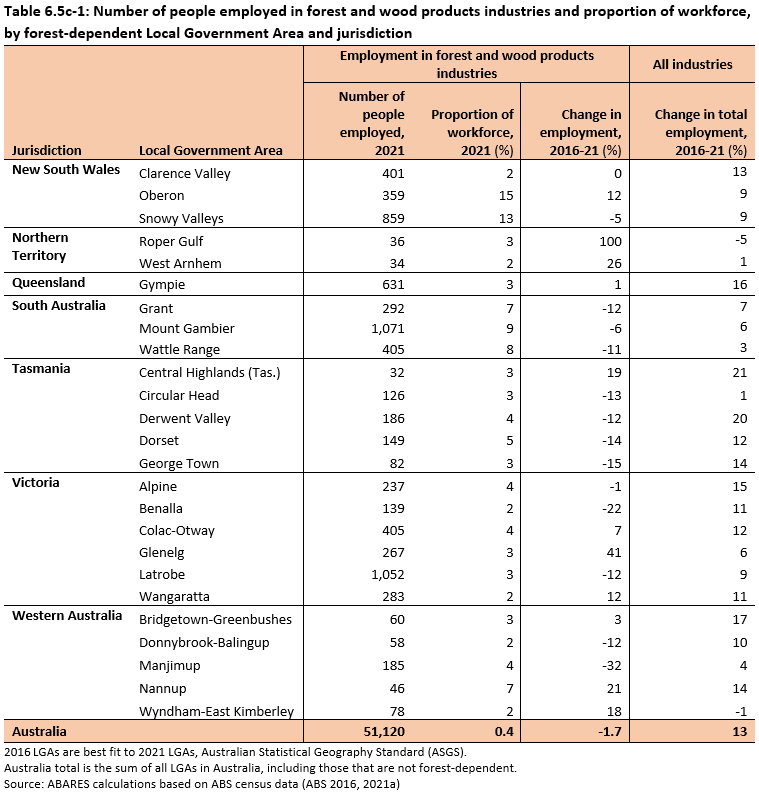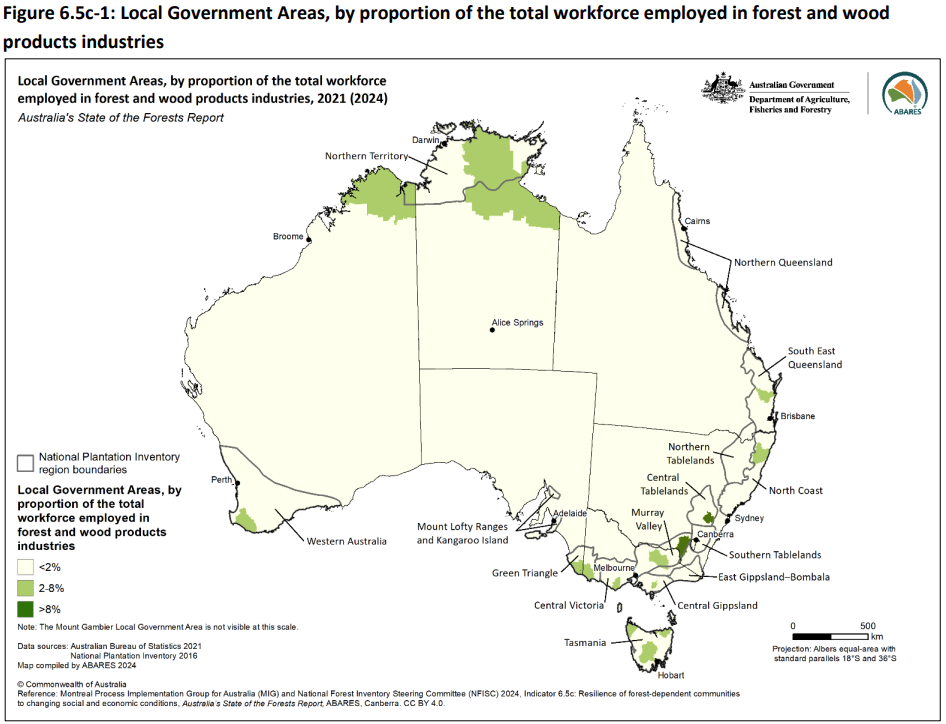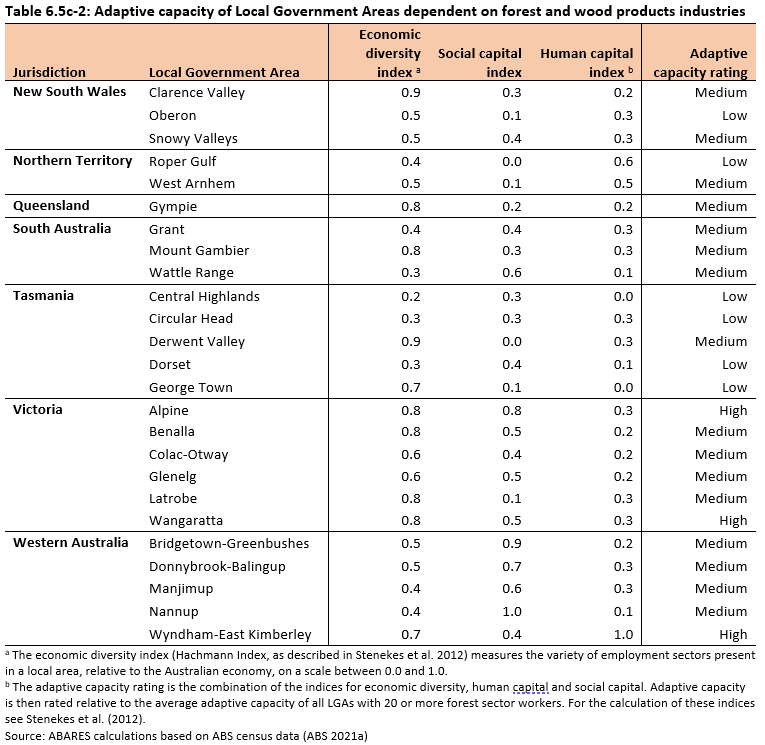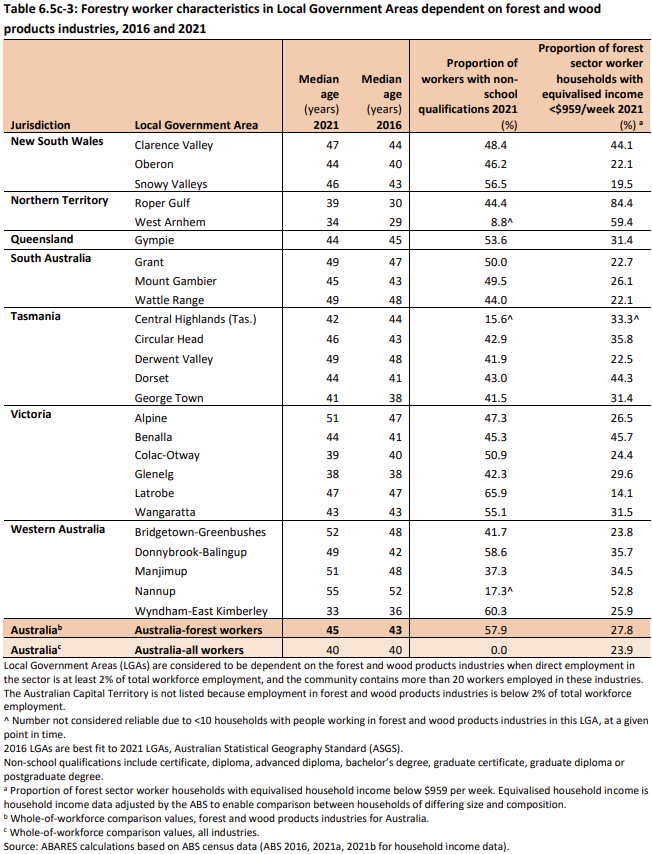This Indicator provides a measure of the extent to which forest dependent communities are able to respond and adapt to change successfully. Resilient forest dependent communities will adapt to changing social and economic conditions, ensuring they remain viable into the future.
This is the Key information for Indicator 6.5c, published July 2024.
Information on the resilience of forest-dependent Indigenous communities to changing social and economic conditions is presented in Indicator 6.5d.
- A total of 25 Local Government Areas (LGA) were assessed as dependent on forest and wood products industries, all occurring in major areas of plantation development and native forest sector employment.
- Three LGAs had 9% or more of the workforce employed in forest and wood products industries: Oberon and Snowy Valleys in New South Wales, and Mount Gambier in South Australia.
- Workers in forest dependent communities are typically older, have lower rates of non-school qualifications, and lower household incomes.
The information provided in this indicator can be used to inform our understanding of the resilience of forest-dependent communities to changing social and economic conditions.
The resilience of forest-dependent communities is conceptualised through:
- community dependence on forest and wood products industries
- community adaptive capacity, represented by a combination of economic diversity of industries that provide employment within the community, and the social capital and human capital resources available in the community, and
- selected characteristics that contribute to resilience at the level of individual workers.
For this Indicator, indices were calculated using data from the 2021 Australian Bureau of Statistics Census of Population and Housing. More information can be found in Supporting information for Indicator 6.5c.
A total of 25 Local Government Areas (LGAs) were assessed as dependent on the forest and wood products industries in 2021 (Table 6.5c-1). All forest-dependent LGAs are located in major areas of plantation development and native forest sector employment. Three LGAs had 9% or more of the workforce employed in forest and wood products industries: Oberon and Snowy Valleys in New South Wales, and Mount Gambier in South Australia, all of which are plantation-based regions (Figure 6.5c-1).
Employment in the forest and wood products industries decreased slightly by 1.7% from 2016 to 2021, compared to a 13% increase nationally across all industries (Table 6.5c-1, see also Indicator 6.5a). Employment in forest and wood products industries increased in 11 of the 25 forest-dependent LGAs, whereas total employment grew in 23 of the 25 LGAs. The largest proportional increases in forest and wood products industries employment were in the Central Highlands (Tasmania; 19%), Glenelg (Victoria; 41%), Roper Gulf and West Arnhem (Northern Territory; 100% and 26%, respectively) and Wyndham-East Kimberley and Nannup (Western Australia; 18% and 21%, respectively).
This indicator uses data from the 2021 ABS Census of Population and Housing, and therefore does not capture the potential impact of recent policy decisions to cease most native forest harvesting on public land in Victoria and Western Australia from January 2024.
Click here for a Microsoft Excel workbook of the data for Table 6.5c-1.
Six Local Government Areas (LGAs) dependent on forest and wood products industries (four in Tasmania, and one in each of New South Wales and the Northern Territory) had a low adaptive capacity rating in 2021 relative to other forest-dependent LGAs, while three had a high adaptive capacity rating (Wyndham-East Kimberley in Western Australia, and Wangaratta and Alpine in Victoria) (Table 6.5c-2).
Community resilience is hard to measure quantitatively, but measures of community adaptive capacity can be used as a proxy for community resilience. Quantitative indices of economic diversity, human capital, and social capital are used to represent adaptive capacity within a community (Stenekes et al. 2012). Higher levels of these indices can indicate greater adaptive capacity and potential resilience to industry change of both communities and individuals. Information on community resilience and the associated indices can be found in Supporting information for Indicator 6.5c.
Click here for a Microsoft Excel workbook of the data for Table 6.5c-2.
Reference
Stenekes N, Reeve I, Kancans R, Stayner R, Randall L, Lawson K (2012). Revised indicators of community vulnerability and adaptive capacity across the Murray–Darling Basin: a focus on irrigation in agriculture. ABARES report to client prepared for the Murray–Darling Basin Authority, Canberra, December.
Median age, qualifications and household income of workers vary across the Local Government Areas LGAs dependent on forest and wood products industries. An individual's ability to adapt to change is difficult to quantify, because changes in any industry, including the forest and wood products industries, can affect individuals differently independent of their situation in the broader community. Age, qualification and skills, and income influence the individual resilience of workers and can indicate their ability to adapt to change.
In 2021, the median age of the national forestry workforce was 45, ranging from 33 to 55 years across the 25 forest-dependent LGAs (Table 6.5c-3). Between 2016 and 2021 there was a small increase in the median age across most LGAs, and only one LGA in each of Queensland, Tasmania, Victoria and Western Australia had younger forest sector workers in 2021 than in 2016. Older workers may find it more difficult to find alternative employment.
Nationally, 58% of forestry workers had non-school qualifications in 2021 such as certificates, diplomas or degrees, compared with 69% in the total workforce (Table 6.5c-3). In most communities, the proportion of forestry workers with non-school qualifications increased between 2016 and 2021. Qualifications and formal skills recognition can increase opportunities for workers, meaning they are more able to adapt to change.
Nationally, the proportion of forest sector worker households with weekly incomes below the median household equivalised income ($959) was slightly higher (28%) than for total workforce households (24%) (Table 6.5c-3). Household incomes are likely a better indicator of the overall ability of workers to meet living costs than individual income. Workers with a higher household income may have more financial resources to meet cost of living or adapt to change.
Click here for a Microsoft Excel workbook of the data for Table 6.5c-3.
Further information
- Data sources
- Community and individual resilience
- Indicating resilience – Community adaptive capacity
- Indicating resilience – Individual forest industry workers




